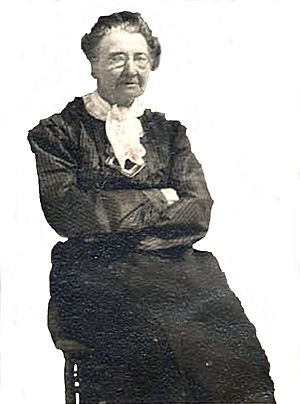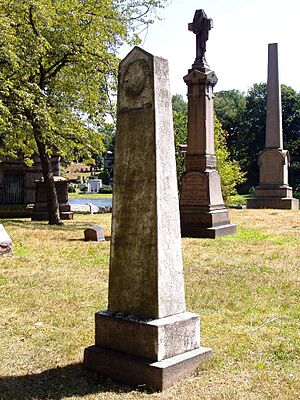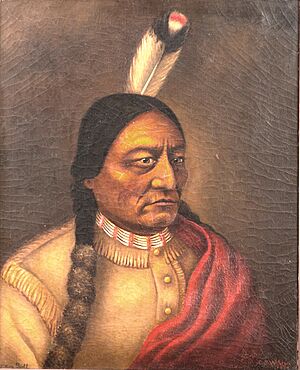Caroline Weldon facts for kids
Quick facts for kids
Caroline Weldon
|
|
|---|---|

Weldon in 1915
|
|
| Born | Susanna Karolina Faesch 4 December 1844 Kleinbasel, Canton Basel, Switzerland |
| Died | 15 March 1921 (aged 76) Brooklyn, New York, United States |
| Pen name | Caroline Weldon |
| Occupation | Artist, Indian Rights activist |
| Nationality | Swiss, American |
Caroline Weldon (born Susanna Karolina Faesch; December 4, 1844 – March 15, 1921) was a Swiss-American artist. She was also an activist who worked to protect the rights of Native Americans. Weldon became a close friend and helper to Sitting Bull, a famous leader of the Lakota Sioux tribe. This was during a time when many Plains Indians were involved in the Ghost Dance movement.
Early Life and Family
Caroline Weldon was born Susanna Karolina Faesch on December 4, 1844. Her birthplace was Kleinbasel, in Basel, Switzerland. Her father, Johann Lukas Faesch, was a Swiss military officer. Her mother was Anna Maria Barbara, whose maiden name was Marti. Caroline was part of the Faesch family, a well-known family in Switzerland.
In 1852, she moved to America with her mother. They settled in Brooklyn, New York. That same year, her mother married again to Dr. Karl Heinrich Valentiny. He was a doctor from Germany who had moved to Brooklyn. In 1866, Susanna married Dr. Bernhard Claudius Schlatter, who was also a Swiss doctor. Their marriage did not last.
Later, she had a son named Christie. She then returned to Brooklyn to live with her mother and stepfather. Her marriage to Bernhard Schlatter ended in 1883.
Helping Native Americans
After her marriage ended, Caroline Weldon became very interested in helping Native Americans. In 1887, her mother passed away, and Caroline inherited some money. This allowed her to follow her passions, including art. Around this time, she changed her name to Caroline Weldon. This was likely to start fresh.
In the summer of 1889, Caroline Weldon traveled to Dakota Territory. She wanted to live among the Sioux people. She joined a group called the National Indian Defense Association (NIDA). This group worked to protect Native American rights. Weldon helped the Sioux fight against the U.S. government. The government was trying to take large parts of the Great Sioux Reservation. They wanted to open this land for new settlers.
Weldon became friends with Sitting Bull, a key leader of the Sioux. She worked as his secretary and helped him communicate. She also painted four portraits of Sitting Bull. Two of these paintings still exist today. One is in North Dakota, and the other is in Arkansas.
Caroline and her young son Christie moved to Sitting Bull's home. It was located on the Grand River at the Standing Rock Indian Reservation. She often disagreed with the government's Indian Agent, James McLaughlin. This made him dislike her. McLaughlin started spreading false rumors about her. Because of this, many white people and newspapers spoke badly about her.
When the Ghost Dance Movement became popular in 1890, she did not support it. Weldon warned Sitting Bull that this movement could cause trouble. She feared it would give the government a reason to send the military. She worried this would harm the Sioux Nation. Sitting Bull became upset with her. When her son became ill in November, she decided to leave.
While traveling on a boat, her son Christie passed away on November 19, 1890. This happened near Pierre, South Dakota. Soon after, Sitting Bull was killed on December 15, 1890. Then, the Wounded Knee Massacre happened on December 29, 1890. These sad events made her feel that her efforts had failed. She lived briefly in Kansas City with her nephew. Eventually, she returned to Brooklyn and lived a quiet life.
Later Life and Legacy

Caroline Weldon died alone in her Brooklyn apartment on March 15, 1921. She passed away due to an accidental fire. She was buried in the Valentiny family plot. This plot is at Green-Wood Cemetery in Brooklyn, New York.
Her life has been remembered in art and film. The writer Derek Walcott mentioned Weldon in his play The Ghost Dance. He also wrote about her in his long poem Omeros. These works connect Native American history with other cultures.
The movie Woman Walks Ahead tells the story of Caroline Weldon's time with the Sioux.
Green-Wood Cemetery in Brooklyn also honored her. In March 2018, they held a special tour called "Women Who Walked Ahead." This tour visited the graves of important women from Brooklyn, including Caroline Weldon.


